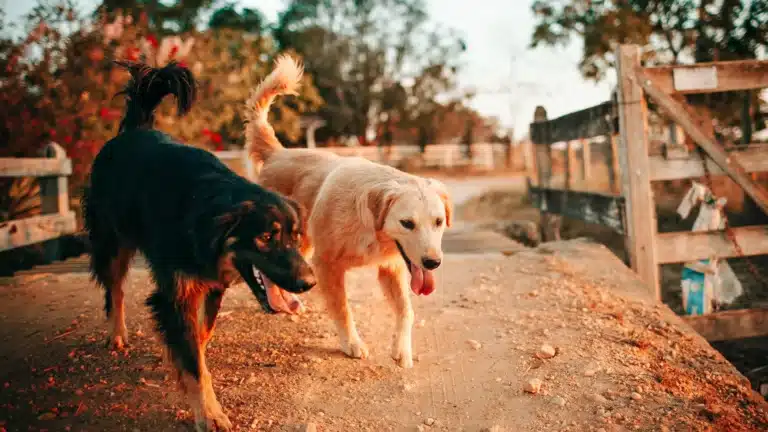How do dogs communicate with each other
Dogs are truly amazing animals with unique ways of communicating! Even though they can’t talk like we do, they show their feelings and interact socially through body language, sounds, scents, and facial expressions. When you watch dogs play and meet each other at the park, you can discover a whole world of communication that often goes unnoticed.
As social creatures, dogs have many ways to connect with us and their furry friends! They express themselves with cheerful barks, wagging tails, and subtle changes in their posture. By learning these fun ways of communicating, we can better understand our pets and respond to their needs with love and care.

The Power of Body Language in Dog Communication
Dogs communicate with each other mainly through different body language. Their posture, tail position, ear movements, and facial expressions all play significant roles in communicating messages. For example, a dog standing tall and stiff typically displays dominance or aggression. At the same time, a crouched position with a tucked tail often indicates fear. When a dog does a play bow, lowering its front half to the ground while happily wagging its tail, it’s like sending out a friendly invitation to play!
Tail Wagging: More Than Just Happiness
One of the ways dogs communicate with each other is through body language. Contrary to popular belief, wagging tails do not always indicate happiness. Dogs wag their tails for different reasons, and the speed, position, and stiffness of the tail all contribute to its meaning:
- A slow, relaxed wag often indicates friendliness and curiosity.
- A fast, high wag suggests excitement or arousal.
- A stiff, slow-moving wag can signal tension or uncertainty.
- A low, tucked tail means fear, submission, or anxiety.
- A tail held high and wagging strongly can be a sign of dominance or alertness.
Ears: Listening and Expressing
When dogs interact, you may see one dog’s ears perk up in interest while another’s flattened in submission. Just like tails, dogs also use their ears to communicate emotions and intentions:
- Ears forward indicate alertness or curiosity.
- Ears relaxed and slightly back suggest friendliness and comfort.
- Ears pinned back tightly often signal fear, submission, or stress.
Facial Expressions: More Than Meets the Eye
Watch two dogs interacting, and you’ll notice how they read each other’s facial cues to determine the mood of the encounter.
- Relaxed mouth and soft eyes signal a calm and friendly mood.
- Raised lips and bared teeth warn of aggression or discomfort.
- Yawning (outside of sleepiness) can be a sign of stress or an attempt to calm another dog down.
- Licking their lips can indicate nervousness or submission.
Vocalizations: How Dogs "Talk" Through Sound
Dogs aren’t silent communicators; they also use a variety of sounds to express themselves. Barks, growls, whines, and howls all carry different meanings.
Barking: A Multifunctional Tool
Dogs primarily communicate with each other through barking, which serves multiple functions in their interactions. The various reasons behind a dog’s barking often reflect their emotions and intentions, highlighting the complexity of their communication.
- Excitement: A high pitched, repetitive bark often signals excitement or playfulness.
- Warning or alert: A sharp, loud bark is commonly used to warn other dogs or humans of potential danger.
- Attention-seeking: Some dogs bark to seek attention from their owners or other dogs.
- Territorial defense: A deep, continuous bark warns intruders to stay away.
Growling: Not Always a Threat
Dogs interpret growls by considering the pitch and intensity to determine if they are playful or serious. Understanding the context is important; observing additional cues such as facial expressions and body posture can help differentiate between playful and aggressive growling. Thus, growling isn’t solely a sign of aggression; it can have various meanings depending on the situation.
- Playfulness: Some dogs growl during playtime as a way of adding excitement.
- Warning: A low, steady growl can mean “back off.”
- Discomfort: If a dog feels threatened or uneasy, it may growl to set boundaries.
Whining and Whimpering: A Call for Attention
Dogs often whine as a form of communication, expressing emotions such as submission, anxiety, or a desire for attention. Puppies frequently whimper to convey feelings of hunger or discomfort. At the same time, adult dogs may use whining to seek reassurance from their owners or to signal distress. This behaviour can also reflect excitement, such as when anticipating a walk. The instinct for whining often develops in puppies as a way to get attention from their mothers, and it can persist throughout a dog’s life.
Howling: The Call of the Wild
Howling is a primal form of communication among canines, deeply rooted in the behaviour of their ancestors, the wolves. It serves various purposes, including signalling location to other dogs. Certain breeds, such as Huskies, are more inclined to howl due to their strong instinctual ties to their wolf ancestors. Dogs often respond to specific sounds, like sirens or music, by joining a howling session. Howling can even become a bonding experience in multi-dog households, resembling a family sing-along.
Scent Communication: The Language of Smell
Dogs have a remarkable sense of smell, up to 100,000 times more sensitive than humans. While humans primarily rely on sight and sound for communication, dogs communicate significantly through scent signals, highlighting the importance of smell in their interactions with the world around them.
Marking Territory
Dogs often pee in certain spots to mark their territory and communicate with each other. When a dog sniffs an area where another dog has urinated, it can learn important things, like the other dog’s sex, age, health, and mood. By marking these spots, dogs not only show that they’ve been there, but they also help create a kind of social network. This allows them to understand more about other dogs, such as their identity and whether they are ready to mate.
Scent Glands and Social Bonds
Dogs communicate through scent in remarkable ways, using special glands in their paws, faces, and tails. When they rub against objects or one another, they leave behind their unique scent, which serves a purpose similar to exchanging business cards among humans. One of the most fascinating aspects of this communication is scent-marking. With their extraordinary sense of smell, dogs share information about themselves and pick up on signals from other dogs.
Play Behavior: Social Bonding Through Actions
Dogs share their feelings and intentions not just through vocalizations but also through play behaviours. Understanding how dogs communicate requires observing these behaviours in different contexts, such as play, aggression, and social interactions, as each scenario influences how signals are expressed and understood. Some behaviours include:
- Play: One gesture is the play bow, where a dog lowers its front legs while keeping its rear end elevated, which invites another dog to join in the fun. Even during spirited play that may become a bit rough, dogs often pause to assure their playmate knows it’s all just for fun.
- Chasing: This playful activity is a friendly and instinctive way to interact socially, allowing dogs to test their agility and speed. It allows them to play together, showing how quickly they can react.
- Pawing and Gentle Mouthing: These gestures represent a playful approach to initiating interaction. Pawing can indicate a desire for attention or playfulness, while gentle mouthing signifies curiosity and affection. Both actions are essential methods of communication that help build trust and establish social connections.
- Bouncing Movements: Characterized by energetic and rhythmic leaps or hops, these movements signify excitement and exuberance. Bouncing is not only an expression of joy but also invites others to join in the fun, creating a lively and engaging environment that encourages ongoing play.
Understanding Social Hierarchies in Dog Communication
Dogs are social animals, and when they interact in a group, they establish a social hierarchy. This doesn’t always mean dominance but rather a structured way of determining who leads and who follows. These social cues help prevent conflicts and maintain peace among dogs.
- Confident dogs: They may maintain direct eye contact, which gives a sense of attentiveness and assertiveness. These dogs tend to stand tall, and their bodies relaxed, showing strength and composure. Their tails are usually held high, often wagging in a steady, eager manner, showing their confidence and are happy to engage. This shows their willingness to interact with people and other dogs.
- Submissive dogs: They often display specific behaviours to communicate their non-threatening behaviour. They may roll onto their backs as a gesture of trust and vulnerability and may also avoid direct eye contact (staring can be sensed as a challenge or a threat). By showing these postures, they express their desire to create a peaceful environment and ensure they pose no danger.
- Aggressive dogs: Aggression is a natural part of dog behaviour that needs careful management. Some signs of aggression include a rigid body, direct stare, bared teeth, and growling. Understanding these facial expressions can help prevent conflicts between dogs. Allowing owners to step in before confrontation arises.
Understanding how your dog communicates is important for dog owners who want to build their relationship with their pets. Paying attention to your dog will help reduce their stress and prevent behavioural issues. Responsible pet owners must listen and respond with understanding and patience.
